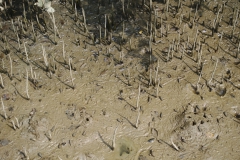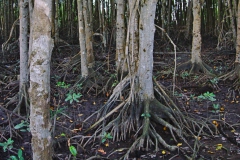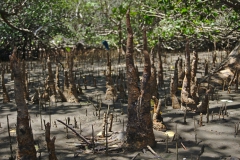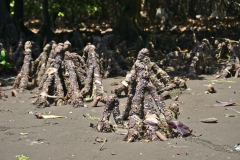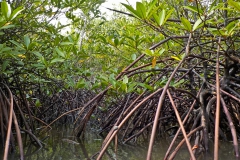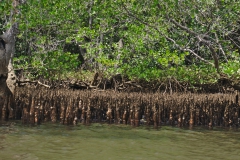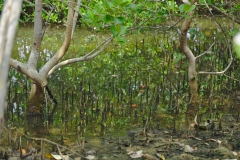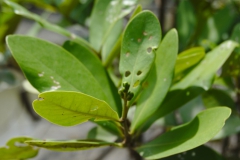What are mangroves?
Mangroves are coastal intertidal forests, growing in tropical and subtropical latitudes. They consist of trees, shrubs, palms and ground ferns. Together, they form a unique ecosystem. A special feature of mangrove trees is their highly developed root system by which they stick to the soft ground. It will be differentiated between: prop roots, knee roots, pencil roots, cone roots and buttress roots. The term ‘mangrove’ describes both the ecosystem as a whole, as well as the plant species that it comprises. In total there are around 70 species (Hogarth, 2015).
Where do mangroves grow?
Mangrove forests grow in 118 countries near the equator (Figure 1). They cover only 0.1% of the earth continental surface, 0.7% of the tropical forest area (Giri et al., 2011) and 0.5% of the world’s coastal area (Alongi, 2014) The Indo-West Pacific region holds the largest and species-richest (> 60 species) mangrove forests, wheras the region of the Atlantic-West Pacific is species-poor (< 15 species). Asia has the world’s largest mangrove area with 38.7%, followed by Latin America and Caribbean with 20.3%, Africa with 20.0%, Oceania with 11.9%, North America with 8.4% and European overseas territories with 0.7% (Bunting et al., 2018). Mangroves need water temperatures of at least 20 °C, which is why they do not occur in areas of cold ocean currents. They grow in muddy, oxygen-poor soils and are subject to tides and high salt fluctuations. They grow in coastal areas within the intertidal zone e.g. river deltas, estuaries and coastal lagoons (Hogarth, 2015).

The Sundarbans
The world largest mangrove forest – the Sundarbans (in German “beautiful forest”) – covers 10,000 km2, and is located in the delta of the Ganges, Brahmaputra and Meghna rivers in the Bay of Bengal. The forest is being shared between India (38%) and Bangladesh (62%). It is inscribed as UNESCO World Heritage Site since 1987 and considered an important biodiversity hotspot – it is home to several endangered species: the Bengal tiger, the fishing cat, the Irrawaddy dolphin and the horseshoe crab.
Based on historical data, the Sundarbans in East India have been considered as endangered ecosystem by the International Union for Conservation of Nature (IUCN). Clearing and declining fish populations drove a status of Endangered. Historically, the area of the Sundarbans in India was estimated to be 6588 km2, in 1776, of which only 1851 km2, remained in 2016. Four million people depend on the ecosystem services of the mangrove forest. Wild fishing makes the second largest employment sector. The protection of the Sundarbans is therefore necessary for both biodiversity and humans (Sievers et al., 2020).
On May 20, 2020, the super cyclone Amphan hit the Bay of Bengal. Amphan caused enormous damage and devastation along the coastal region. Amphan not only left a major humanitarian crisis, but damaged much of the Sundarbans. According to the government of West Bengal, around 1,200 km² of mangrove forests in the Sunderbans were damaged by cyclone Amphan (The Hindu).
Klicken Sie auf den unteren Button, um den Inhalt von www.globalforestwatch.org zu laden.
How do mangroves survive?
The mangrove habitat is harsh – with muddy, low-oxygen soil, tidal changes and high salinity fluctuations. Different physiological and morphological adaptions allow them to live here. The most striking are the different forms of aerial roots. The above-ground root organs ensure that the plant is supplied with oxygen in the oxygen-poor soil and during the flood. So-called lenticels – fine pores – are used for gas exchange. Mangroves are among the halophytes – plants that grow in the saline environment. However, the species differ in their tolerance. In order to survive here, they have various mechanisms to regulate salt concentrations. Some species actively excrete the salt via salt glands, others accumulate the salt in older leaves, so it can be shed with the leaves. Salt absorption on the roots can also be restricted by ultrafiltration (Hogarth, 2015).
How do mangroves reproduce?
The flowers of the mangrove trees are pollinated by insects (including bees, moths, butterflies), bats, birds and by wind. Many mangrove species show vivipary or cryptovivipary. A process by which seeds germinate on the parent tree. The propagule grows by a combination of photosynthesis and acquisition of nutrients from the parent. Later on the propagule will be dispersed. All mangrove plants have buoyant, water-dispersed propagules. They remain viable for a month or longer. The propagule floats on the water until it roots in a suitable place (Hogarth, 2015).
Why should we care about mangrove forests?
Mangrove forests are efficient CO2 sinks and contribute to climate change mitigation (keyword: ‘blue carbon’). They also provide habitat for a variety of animals, serve as coastal protection, improve water quality and maintain livelihood for many people.
What is ‘Coastal Blue Carbon’?
The term ‘coastal blue carbon’ refers to the carbon captured by coastal ecosystems. These include salt marshes, seagrass beds and mangrove forests. Mangroves sequester carbon in their biomass, but especially in their sediment. The waterlogged sediment is anaerobic (low or no oxygen), which is why the decomposition of the enclosed carbon-rich material is very slow. The sediment can be several meters deep. Mangroves remain among the most carbon-rich forest environments – too precious to lose!
UN Sustainable Development Goals: Nature conservation and human rights go hand in hand!
The world forest ecosystems are under pressure, especially in the global south – large-scale deforestation occurs for aquaculture ponds, palm oil and rice plantations. European and North America markets are primarily served. The short-term profit is generated at the expense of long-term destruction of natural ecosystems.
In 2015, the Sustainable Development Goals were agreed upon by the United Nations. The 17 individual goals call for measures to improve people’s living conditions and protect ecosystems and the climate.
The loss of mangrove forests has a direct impact on the climate, biodiversity and social stability:
- Climate change is impacting the world and more and more people are affected by sea-level rise, floods and droughts. Especially in the countries of the global south, natural disasters and extreme weather events occur more frequently and with increasing intensity. In particular, the ones to suffer are the already poor and marginalized in developing countries, whose resilience and adaption capacities are limited. Climate change affects us all – so ecosystems which capture and hold carbon need to be protected.
- Mangroves help maintaining healthy oceans. They are spawning and nursery ground for a variety of fish species and improve water quality of coastal regions. The destruction of mangrove forests will affect us all, no matter in which part of the world we live.
- More than 700 million people live in extreme poverty today (BMZ). Growing inequality increases political and social tensions and leads to instability and conflicts. A world without poverty and hunger is the basis for health, education, equality and social development. Our global well-being is interconnected.

